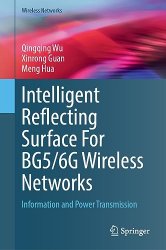Intelligent Reflecting Surface For B5G/6G Wireless Networks: Information and Power Transmission
- Добавил: literator
- Дата: 22-11-2023, 16:18
- Комментариев: 0
 Название: Intelligent Reflecting Surface For B5G/6G Wireless Networks: Information and Power Transmission
Название: Intelligent Reflecting Surface For B5G/6G Wireless Networks: Information and Power TransmissionАвтор: Qingqing Wu, Xinrong Guan, Meng Hua
Издательство: Springer
Серия: Wireless Networks
Год: 2023
Страниц: 188
Язык: английский
Формат: pdf (true), epub
Размер: 24.5 MB
As the fifth-generation (5G) wireless network being deployed worldwide, both academia and industry have been enthusiastically looking into the future beyond 5G (B5G)/sixth-generation (6G) wireless network that targets at meeting more stringent requirements than 5G, such as ultra-high data rate and energy eflciency, global coverage and connectivity, as well as extremely high reliability and low latency. However, these requirements may not be fully achieved with the existing technology owing to the increased hardware and energy cost as well as signal processing complexity. On the other hand, traditional approaches for combating the wireless channel fading mainly compensate for or adapt to it, but have limited control over it, thus leaving the ultimate barrier to achieving high-capacity and ultra-reliable wireless communications unconquered. Motivated by the above, intelligent reflecting surface (IRS) has recently emerged as a promising new paradigm to achieve cost-effective and yet highly spectral and energy-eflcient communications for future wireless networks.
This book provides comprehensive insights into the theory, models, and unique characteristics of intelligent reflecting surface (IRS) and its appealing applications in wireless information and power transmission for B5G/6G. It is organized as follows:
Chapter 1 gives an overview of the fundamentals of IRS, including the signal and channel models of IRS, its hardware architecture, advantages and practical constraints. Chapter 2, 3 and 4 focus on how to optimize the joint design of active and passive beamforming for three types of IRS-aided wireless information/energy transmission systems, namely IRS-aided power transfer (WPT), IRS-aided simultaneous wireless information and power transfer (SWIPT) and IRS-aided wireless powered communication networks (WPCN).
Chapter 2 specifically presents a general framework design for IRS-aided WPT systems from the perspectives of energy beamforming design and channel estimation, while the dynamic IRS beamforming design is also discussed.
Chapter 3 thoroughly studies the IRS-aided SWIPT for achieving better R-E trade-off, wherein two different designs based on weighted sum-power maximization at energy users (EUs) and under individual quality-of-service (QoS), requirements at both information users (IUs) and EUs are investigated.
Chapter 4 presents three paradigms of IRS-aided WPCN, i.e., IRS-aided half-duplex (HD) WPCN, IRS-aided full-duplex (FD) WCPN and IRS-aided multiple-input-multiple-output (MIMO) FD WPCN. The authors present some related emerging topics, e.g., active IRS aided wireless communications and IRS-aided unmanned aerial vehicle (UAV) communications in chapter 5.
The targeted 1000-fold network capacity increase and ubiquitous wireless connectivity for nearly 100 billion devices by the fifth-generation (5G) wireless network have been largely achieved, thanks to the various key enabling technologies such as space division multiple access (SDMA), massive multiple-input multiple-output (MIMO), millimeter wave (mmWave) communication, and ultra-dense network (UDN), and so on. However, the required high complexity and hardware cost as well as increased energy consumption are still crucial issues that remain unsolved. For instance, densely deploying base stations (BSs) or access points (APs) in a UDN not only increases total energy consumption as well as hardware cost, but also introduces significant interference in the network. Moreover, how to provide reliable and scalable backhauls for UDN is a challenging task in practice, especially for indoor deployment without the full optical coverage yet. In addition, extending massive MIMO from sub-6 GHz to mmWave frequency bands requires more complex signal processing, which inevitably incurs huge power consumption caused by a large number of radio frequency (RF) chains. Therefore, research on finding spectral and energy efficient, and yet cost-effective solutions for future/beyond-5G and 6G wireless networks is still indispensable.
Although the 5G physical layer technologies are generally capable of adapting to the space and time varying wireless environment, the signal propagation is essentially random and largely uncontrollable. Recently, IRS has been proposed as a promising new technology for reconfiguring the wireless propagation environment. Specifically, the IRS is a planar surface comprising a large number of low-cost passive reflecting elements, each of which can induce an amplitude and/or phase change to the incident signal independently, thereby collaboratively achieving fine-grained three-dimensional (3D) reflecting beampattern. In a sharp contrast to the existing wireless link adaptation techniques at transmitter/receiver, the IRS is able to proactively modify the wireless channel between them via highly controllable and intelligent signal reflection. This thus provides a new degree of freedom (DoF) for practical system design and potentially realizes a reconfigurable wireless propagation environment. In addition, by properly adjusting the 3D passive beamforming, the signal reflected by IRS can add constructively with those from the other paths to enhance the desired signal power at the receiver, or destructively to cancel the undesired signal such as co-channel interference. Furthermore, since IRS is a passive component, which can be densely deployed with scalable cost and low energy consumption. Last but not the least, IRS can be composed of large numbers of dielectric scatterers with a very limited size.
This book targets postgraduate students studying electrical engineering and Computer Science, and can be used as a secondary textbook. Professionals, researchers and engineers working in wireless networks will also find this book useful as a reference.
Скачать Intelligent Reflecting Surface For B5G/6G Wireless Networks: Information and Power Transmission
Внимание
Уважаемый посетитель, Вы зашли на сайт как незарегистрированный пользователь.
Мы рекомендуем Вам зарегистрироваться либо войти на сайт под своим именем.
Уважаемый посетитель, Вы зашли на сайт как незарегистрированный пользователь.
Мы рекомендуем Вам зарегистрироваться либо войти на сайт под своим именем.
Информация
Посетители, находящиеся в группе Гости, не могут оставлять комментарии к данной публикации.
Посетители, находящиеся в группе Гости, не могут оставлять комментарии к данной публикации.
